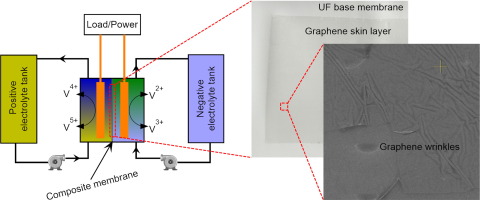侧边栏
Graphene enhances the proton selectivity of porous membrane in vanadium flow batteries
Materials & Design 2017, 113, pp 149–156 (5 January 2017)
By Qing Chen, Yu-Yu Du, Kai-Min Li, Hui-Fang Xiao, Wei Wang* and Wei-Ming Zhang*
j.matdes.2016.10.019, local fulltext
The vanadium flow battery (VFB) is one of the most promising technologies for large-scale energy storage, which has an enormous advantage in the stabilization and smooth output of renewable energy. As an essential separator in VFB, nanoporous membrane plays a key role in the final electrochemical performance, which requires both high H+ conductivity and low vanadium permeability. In this work, a novel graphene enabled porous membrane material has been successfully designed and fabricated by directly transferring several layers of graphene onto the surface of traditional polyethersulfone ultrafiltration membrane. The experimental results show that the graphene layers will impact the composite membranes performance in batteries. After three graphene single layers attached, the proton selectivity of membrane is significantly enhanced, and the overall battery efficiencies are improved by 10% at 20 mA cm− 2. Therefore, attaching graphene layers is a feasible and promising strategy to improve the performance of nanoporous membrane in VFB applications.


